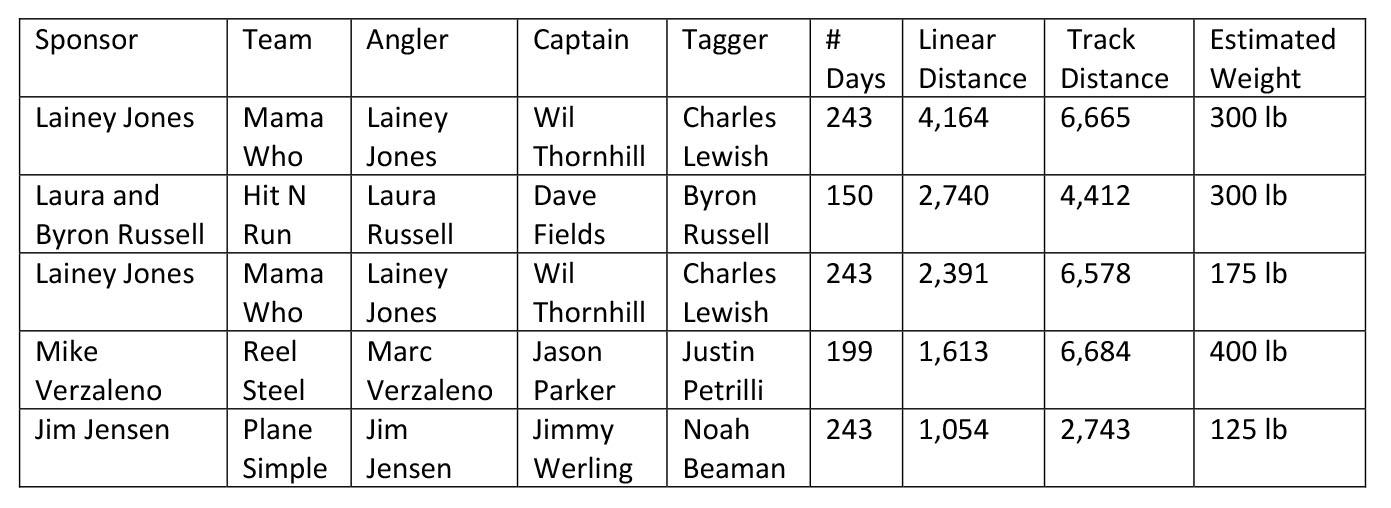2018 IGMR Bermuda Triple Crown Results
New Tags Provide Incredible Tracks!
The results are in from the IGFA Great Marlin Race (IGMR) that was held at the 2018 Bermuda Triple Crown and what a race it was! Last year, the IGMR began using satellite tags manufactured by Microwave Telemetry and the Bermuda Triple Crown was the first race where these tags were deployed.
In total, five tags were deployed on blue marlin and all five reported back data. What’s most impressive about this race is that three of the five tags went the full deployment duration of 240 days, with the remaining two tags staying on for 150 and 199 days. These are exceptional results, as anyone who’s done satellite tagging research on billfish can attest that keeping tags on marlin for long periods of time is about as difficult as keeping a balloon on the antenna of a Porsche going 150 miles per hour on the Autobahn.
All told, the combined linear point-to-point distance recorded by the five tags was 11,962 nautical miles with an estimated total track distance of 27,082 nautical miles. However, the marlin that traveled the farthest was responsible for 35% of the total linear distance. Long-time IGMR supporter Lainey Jones sponsored the winning tag that was deployed from her boat Mama Who on August 1, 2018. When the tag popped off the estimated 300-pound blue off the coast of Africa on April 1st, 2019 it reported a linear point of deployment to point of popup distance of 4,164 nautical miles and estimated track distance of 6,665 miles.
The tracks from this race revealed some interesting trends in migratory behavior. Four of the five tagged marlin swam east after tagging, with two of the tags reporting just off the coast of West Africa. The tag that stayed on the shortest amount of time (150 days) was sponsored by Laura and Byron Russell and came in second place with a linear distance of 2,740 nautical miles. The Russell’s marlin swam north and east almost to the Azores and then southeast and finally south where the tag popped off just east of Cape Verde. Tag deployments from Bermuda in previous years have also demonstrated the tendency for marlin to undertake eastward migrations and several other marlin have also had tags report in the vicinity of Cape Verde.
Here’s the total breakdown:

The results this race further highlight the extreme highly migratory nature of blue marlin. These animals have a capacity for traversing long distances in relatively short periods of time that is rivaled by few other fish. It also further demonstrates the need for better international management for this species, as these fish transcend national jurisdictions.
The Atlantic blue marlin stock is in an overfished state and is still experiencing overfishing. Further reductions in commercial catch and the adoption of circle hooks in longline fisheries to facilitate live release of blue marlin are essential to reduce fishing mortality and give the stock a fighting chance at rebuilding. However, recreational anglers still need to do their part as well. Release as many of these fish as you can and in a manner that gives them the best chance for survival. Remember, the blue marlin you catch in any given location in the Atlantic are also likely the same animals that anglers on the other side of the pond fish for.
The IGFA thanks the tag sponsors, anglers and crews that participated in the 2018 Bermuda Triple Crown IGFA Great Marlin Race. We would also like to thank the Bonnier Corporation and especially tournament director Dan Jacobs for his invaluable assistance in facilitating yet another successful tagging event in Bermuda.
